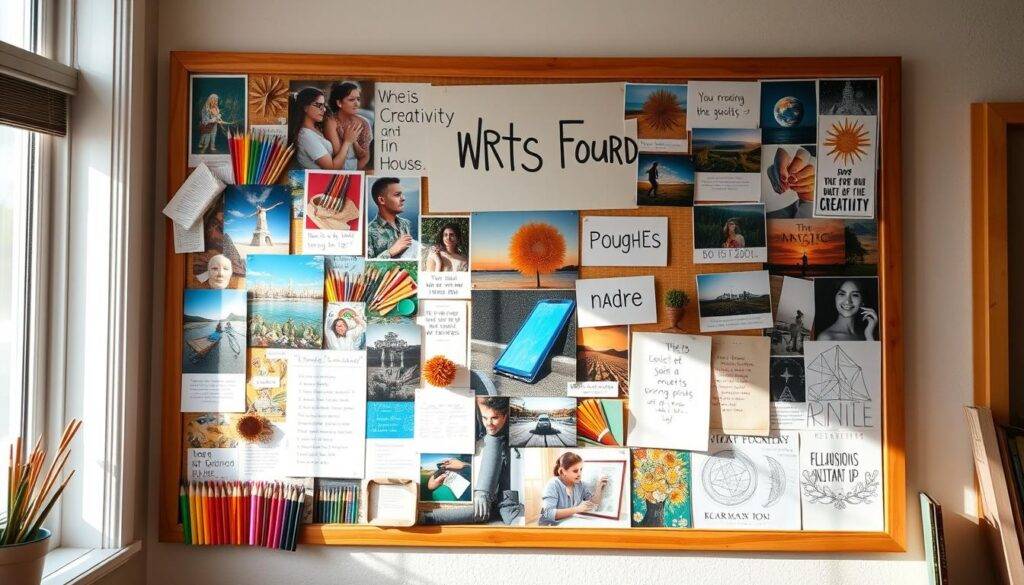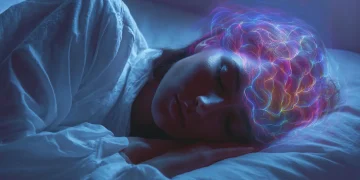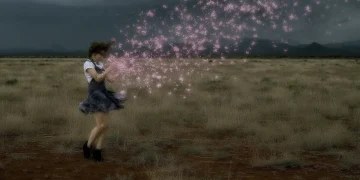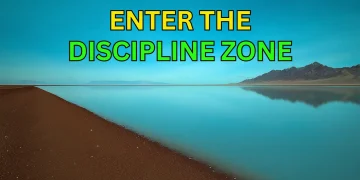“The true sign of intelligence is not knowledge but imagination.” – Albert Einstein
Imagination sparks creativity, leading to new ideas and solutions. In today’s fast-changing world, being able to visualize is a big advantage. Visualization helps turn your ideas into real things.
This guide explores how visualization works, its benefits, and how to use it. You’ll learn to see things differently, think outside the box, and make your dreams come true.
Key Takeaways
- Visualization is a powerful tool for enhancing creativity and imagination.
- The science behind visual thinking reveals the brain’s remarkable ability to process and utilize mental imagery.
- Incorporating visualization techniques into your daily routine can boost problem-solving skills and foster innovative thinking.
- Combining visualization with mindfulness practices can amplify the benefits for creative expression and personal growth.
- Developing strong visualization skills empowers you to transform your creative goals into tangible achievements.
Understanding the Power of Mental Imagery
Mental imagery and visual thinking are powerful tools. They can unlock your creative potential and help you vividly imagine your desired outcomes. By activating the same brain regions involved in perception and memory, mental imagery can enhance your recall, experiential simulation, and ability to problem-solve.
The Science Behind Visual Thinking
When you engage in mental imagery, you’re tapping into the cognitive resources of your brain. The primary visual cortex processes visual information. The prefrontal cortex and parietal lobe are involved in higher-order cognitive processes. This interplay between perception and cognition is what makes visual thinking such a powerful tool for unlocking your imagination techniques and fueling your creative visualization.
How the Brain Processes Visual Information
Mental imagery can take various forms, from episodic (specific events) to semantic (general knowledge or concepts). The vividness and detail of these mental images can vary based on individual differences, emotional states, and attentional mechanisms. By harnessing the power of visualization, you can create immersive mental pictures. These can significantly reduce anxiety, enhance performance, and boost your creativity.
The Role of Mental Imagery in Creative Processes
Visualization is a versatile tool that can be applied in various contexts, from athletic preparation to therapeutic interventions. By creating a conducive atmosphere, engaging all your senses, and setting specific goals, you can unlock the transformative potential of creative visualization. Research has shown that regularly practicing visualization techniques can lead to a 67% increase in goal attainment. It also improves long-term goal clarity and strategic planning by 45%. Additionally, it boosts self-belief and confidence by 53%.
The Mind’s Eye: Historical Perspective and Evolution
The idea of the “mind’s eye” has been important in human history. It started with Cicero talking about orators using similes. The term first appeared in English in Chaucer’s Canterbury Tales. It meant seeing with “the eyes of his mind.”
This shows how long people have valued mental images. They are key to our thinking and creativity.
As time went on, we learned more about visual thinking. A Vanderbilt University study found that mental images change how we see things. People mostly saw what they imagined during tests.
This study was backed by the National Institutes of Health and others. It shows how creative visualization and imagination techniques shape our views. Using the mind’s eye can open up new ways to be creative.
“The thesis ‘The Mind’s Eye: Visualizing Montage Theory’ emphasizes the importance of creativity and discovery in composition as an evolving and innovative activity, with montage theory revolutionizing the integration of text, images, and graphics into a single medium.”
Understanding the mind’s eye is growing. This means we can use visual thinking to improve creative visualization and imagination. This history helps us see how powerful the mind’s eye is for our creativity and thinking.
Visualization for Enhancing Creativity and Imagination
Creative visualization is a powerful tool that can unlock your hidden creative potential. It uses mental imagery to boost problem-solving skills and creativity. It can also help you come up with new ideas. Studies show it improves performance in athletes, and many successful people credit it for their success.
Core Components of Creative Visualization
The creative visualization process has four main stages: image generation, maintenance, inspection, and transformation. These stages help you create, keep, explore, and change mental images. Adding these to your daily routine can lead to great results, as seeing your dreams and goals can boost your confidence and commitment.
Stages of Visualization Practice
- Image Generation: Use your imagination to create clear mental pictures of what you want.
- Image Maintenance: Keep these mental images strong and focused in your mind.
- Image Inspection: Look closely at your mental images to find new insights and possibilities.
- Image Transformation: Try changing and reshaping your mental images to spark creativity and solve problems.
Building Mental Images for Creative Success
Guided visualizations offer a structured way to explore new ideas and spark creativity. Adding gratitude to your visualization practice can make it even more powerful. Keeping a journal of your visualization journey can help you stay focused and committed to your goals.
Using creative visualization can unlock your full creative potential. It’s beneficial for athletes, entrepreneurs, and anyone looking to grow personally. Making it a part of your daily routine can significantly impact your success.
The Neuroscience of Visual Thinking and Creativity
Research shows that visual thinking uses many parts of the brain. These parts handle seeing, remembering, and feeling. This teamwork helps us think creatively and come up with new ideas. Knowing how the brain works with visual thinking can make our creative skills better.
Studies using fMRI have looked at brain activity during rest, thinking about the alphabet, and planning art. They found that the brain’s networks work together more when we’re being creative. This teamwork is even stronger in professional artists.
| Brain Network | Functions |
|---|---|
| Default Mode Network (DMN) | Associated with spontaneous thinking, mind-wandering, and divergent thinking |
| Executive Control Network (EN) | Implicated in cognitive functions such as cognitive control, abstract thinking, decision making, and planning |
Creativity might need both the EN and DMN networks working together. Research shows that when these networks work less against each other, we’re more creative. This means less competition between them.
“Expertise in the visual arts is believed to lead to a higher efficiency in brain areas involved in planning and creating artworks, indicating neuroplasticity and brain adaptation based on specialized training and practice.”
More studies with EEG and fMRI have uncovered how the brain is creative. They found that areas like the early visual cortex and the fusiform gyrus play a big role. This shows that creativity in visual arts is unique and needs its own understanding.
Developing Strong Visualization Skills
Improving your Imagination Techniques, Creative Visualization, and Visual Thinking skills is key to unlocking your creativity. Visualization is a powerful tool for achieving goals, overcoming challenges, and improving mental health. By practicing visualization exercises, you can train your mind to support your success.
Basic Visualization Exercises
Begin with simple visualization exercises like picturing familiar objects or scenes. For example, imagine a lemon and think about its color, shape, texture, and scent. As you get better, try more complex scenarios, like a serene landscape or a cherished memory.
Advanced Visualization Techniques
Expand your creative visualization skills with advanced techniques. Incorporate multiple senses into your visualizations, like the sound of waves or the feel of a breeze. You can also visualize abstract concepts, like ideas or emotions, to improve problem-solving and decision-making.
Overcoming Visualization Blocks
Building strong visual thinking skills takes time and patience. If you hit a block, don’t worry. Use relaxation techniques like deep breathing or meditation to calm your mind and focus. Keep practicing and stay positive to overcome any challenges.
Using Imagination Techniques, Creative Visualization, and Visual Thinking daily can greatly impact your growth. Embrace visualization’s power and unlock your mind’s full potential.
Creating Vision Boards for Creative Goals
Unlock the power of Creative Visualization and Imagination Techniques by making a personalized vision board. A vision board is a real way to show your creative dreams. It helps you focus on what you want to achieve.
Making a vision board takes about an hour. This exercise can change your life. Research shows that visualization gets your subconscious ready for a better life. Just like athletes, you can use Visual Thinking to reach your creative goals.
Vision boards work for both personal and work goals. They can show who you are and what you want. They’re great for sharing ideas or showing your brand. When making a physical board, pick the most important images to use.
To start, look for online guides and videos. They’ll help you make your vision board. Collect images, words, and colors that match your goals. A 12-month vision board can help you plan and stay motivated.
“A vision board can be a powerful tool for improving focus and clarity.” – Pierce Hogan, Owner of Varied Lands
Let your vision board show your dreams. Look at it often to keep your goals in mind. This will inspire you to take action towards your creative dreams.

Mindfulness and Visualization Integration
Using creative visualization with mindfulness can make your mental images more powerful. Mindfulness helps you stay in the present moment. This makes you more focused and open to Mindfulness Visualization exercises. Together, these methods can help you tap into your creativity and imagination.
Meditation Techniques for Enhanced Visualization
Meditation, like focused attention and open monitoring, builds mental strength. Focused attention meditation keeps your mind on one thing, like your breath. Open monitoring lets you notice more of your surroundings and thoughts.
Both methods improve your ability to concentrate and observe mindfully. These skills are key for deep Creative Visualization.
Combining Breathing Exercises with Visual Practice
- Use deep, rhythmic breathing to relax and open up to your visualizations.
- Match your breath with your mental images. This lets your pictures grow with your breath.
- Try breathwork and pranayama to make your visualizations more real.
By mixing Mindfulness Visualization, meditation, and breathwork, you can have more meaningful creative experiences. This combination helps you focus better, feel more balanced, and notice more. It unlocks your full creative potential.
“The mind is a powerful instrument. With practice, we can use it to create the experiences we want, rather than just reacting to the ones that arise.”
Guided Imagery for Creative Problem-Solving
Unlock your inner creative genius with guided imagery. This method of visualization can change how you solve complex problems. It lets you dive into a mental world, unlocking your subconscious mind’s creativity.
Studies show guided imagery boosts memory by up to 10%. Athletes who use it see their performance go up by 5% to 20%. People solving creative problems with imagery find new ideas 15% more often.
Guided imagery means following a story that guides your mind. It helps you see things from new angles and find fresh ideas. It wakes up your brain’s creative side.
“Visualization is the first step in creating anything. The ability to see it, to really see it, is the most important stage.” – Shakti Gawain, author and teacher
Guided imagery is great for work projects or personal creativity. It helps you focus and calm down. This lets you tap into your creative energy and find new solutions.
Start using guided imagery for creative adventures and problem-solving. Unlock your subconscious mind and let your imagination fly. This will lead to amazing ideas and achievements.
Visual Storytelling and Imagination Development
Unlock your visual imagination with visual storytelling. Create vivid mental stories to unleash your creative mind. This fuels innovation and imagination like never before.
Creating Mental Narratives
Building detailed scenarios and characters in your mind is key to imaginative storytelling. Picture complex settings, diverse characters, and exciting plot points. As you mix these elements, your creativity will soar, sparking new ideas.
Story Visualization Techniques
- Imagine yourself in a favorite book, bringing scenes to life.
- Create original stories, letting your creative visualization lead the way.
- Reimagine personal experiences with a fresh twist.
These techniques boost your storytelling skills and improve your ability to create complex mental images. This fuels richer creativity in all areas of your life.
“The true sign of intelligence is not knowledge but imagination.” – Albert Einstein
Embrace visual storytelling to unlock your imagination’s full potential. Develop the habit of creating engaging mental stories. See how imaginative storytelling transforms your creativity and personal growth.
Transformation Through Creative Visualization
Unlock your true potential with creative visualization. This powerful technique can change your thoughts, actions, and life. By imagining your goals and positive changes, you can see yourself differently, feel more confident, and break free from old beliefs.
Visualization does more than just spark creativity. It can improve your overall well-being and success in many areas. Whether you want to grow personally, advance in your career, or find more joy, creative visualization can help.
Discover the magic of visual thinking and imagination techniques. Picture yourself achieving your dreams, feeling confident, and living your best life. By using your mind’s eye, you can make these dreams come true.
Start your journey of change today. See how creative visualization can transform your life. Unlock your full potential and feel the amazing effects of this powerful tool.
| Visualization Technique | Benefits | Frequency of Use |
|---|---|---|
| Vision Boards | Clarity, Motivation, Manifestation | Many times a week |
| Guided Imagery | Stress Reduction, Mental Relaxation | Daily |
| Mental Rehearsal | Performance Enhancement, Skill Development | Regularly before events |
“Visualization is the greatest skill I have ever developed. It has helped me tremendously in my career and in my personal life, and it continues to be a powerful tool for me every single day.” – Arnold Schwarzenegger
Embrace the power of creative visualization and unlock your true potential. Begin your journey to success today.
Practical Applications in Daily Life
Creative visualization, visual thinking, and imagination techniques are more than just for art. They can change our work and personal lives in big ways. They make our daily lives richer and more meaningful.
Professional Applications
In work, creative visualization can be a big help. It lets us think clearly and solve problems better. It also helps us talk better and come up with new ideas.
By seeing success in our minds, we can plan better and work better with others. This helps us grow and succeed at work.
Personal Growth Through Visualization
For personal growth, using visualization techniques every day can change our lives. It helps us reach our goals and find peace and strength inside. It’s like making our dreams come true.
By seeing what we want in our minds, we can make it happen. This can lead to a healthier life, better relationships, and more confidence.
Using creative visualization, visual thinking, and imagination techniques can make us more productive and creative. It can make our lives happier and more fulfilling. By using these practices every day, we can achieve our dreams.
“Creativity is not a talent. It is a way of operating.” – John Cleese
Adding creative visualization and imagination techniques to our daily lives can change our work and personal lives. It lets us think better, solve problems, and grow. It makes our lives more rewarding and happy.
Overcoming Creative Blocks Using Visualization
As a creative professional, you might sometimes hit a creative wall. But, did you know Creative Visualization can help? It lets you see things from new angles and spark your creativity.
Visualization can clear the way for new ideas. 78% of people find their creativity boosts when they use it. It helps you see different ways to solve problems and break through barriers.
Techniques like seeing the creative process in your mind, imagining success, or stepping into new places can lead to breakthroughs. For instance, 45% of writers and creative directors use automatic writing to get past mental blocks and find new ideas.
Visualization empowers individuals to overcome obstacles, cultivate a positive mindset, and achieve personal and professional growth.
Regular use of Visual Thinking and Imagination Techniques can improve your visualization skills. 36% of creatives tell stories with objects to spark their imagination and connect emotionally. Meanwhile, 27% of visual creative professionals use automatic drawing to come up with unique ideas.
By using Creative Visualization in your work, you can unlock your subconscious mind. It helps you focus on your goals and boosts your confidence. This way, you can overcome any creative block that comes your way.

Tools and Resources for Visual Practice
Unlocking your creative potential through Creative Visualization, Visual Thinking, and Imagination Techniques is easier with the right tools. These tools help you improve your visualization skills. They turn your dreams into real things.
Check out guided visualization apps for personalized sessions. They take you to amazing mental places. These apps are great for Visual Thinking, helping you relax, focus, and get creative.
If you like hands-on work, try vision board creation software. It lets you make a digital version of your dreams. This software helps you organize your ideas and make your dreams come true.
Mind mapping tools are great for organizing your thoughts. They help you see connections and come up with new ideas. These tools make Creative Visualization easier, helping you see things from new angles.
Virtual reality experiences can also help. They take you to real places that feel real. This technology is great for deepening your visualization skills and sparking your creativity.
Books, workshops, and online courses can also help. They teach you about visualization techniques. These resources give you the skills to use your mind’s eye to its fullest.
Using these tools and resources can make your Creative Visualization better. It unlocks new levels of Visual Thinking and imagination. Start using these tools to grow personally and professionally.
| Tool/Resource | Description | Benefits |
|---|---|---|
| Guided Visualization Apps | Personalized sessions for relaxation, focus, and creativity | Enhances visualization skills, promotes mental well-being |
| Vision Board Creation Software | Digital platforms for curating visual inspirations and goals | Facilitates the manifestation of dreams and objectives |
| Mind Mapping Tools | Platforms for visually organizing thoughts and generating ideas | Supports creative problem-solving and ideation |
| Virtual Reality Experiences | Immersive environments that engage the senses and stimulate imagination | Deepens visualization practice and unlocks creative expression |
| Books, Workshops, and Online Courses | Structured learning opportunities on visualization techniques | Provides a solid foundation in imagination techniques and their application |
“The true sign of intelligence is not knowledge but imagination.” – Albert Einstein
Measuring Progress in Visualization Skills
Tracking your progress in creative visualization is key to unlocking its full power. By watching how vivid, controlled, and detailed your mental images get, you learn a lot. This helps you see where you can get better.
Tracking Visual Development
Keeping a visualization journal is a great way to track your progress. Write down how clear, long-lasting, and detailed your mental pictures are. You can also use special tests or guided exercises to see how your visual thinking is improving.
Setting Visualization Goals
- Make specific, measurable goals for your imagination techniques. For example, aim to make your mental images clearer or more detailed.
- Break big goals into smaller, easier steps. This helps you keep moving forward and stay motivated.
- Keep checking and changing your goals as you get better at creative visualization.
By tracking your progress and setting clear goals, you can see how far you’ve come. This helps you keep moving forward and fully use creative visualization for personal growth.
“Visualization is the most powerful mind tool we have for creating what we want in our lives.”
– Dr. Shakti Gawain
Common Challenges and Solutions
Using Creative Visualization and Visual Thinking can change your life. But, it comes with its own set of challenges. Keeping your focus, creating clear images in your mind, and believing in the process can be tough.
To overcome these hurdles, start with relaxation techniques. They help calm your mind and body, making you ready for visualization. Start with simple images and get more complex as you get better.
Also, try using affirmations or physical actions with your visualization. This helps make your mental images stronger. By tackling these common problems, you’ll make your visualization practice more effective. This boosts your creativity and personal growth.
FAQ
What is the science behind visual thinking and its role in creative processes?
Mental imagery uses different parts of the brain. It helps us see and think about things in our mind. This makes it easier to imagine and create new ideas.
How can I develop strong visualization skills and overcome common challenges?
Start with simple exercises and move to harder ones. Use techniques like seeing things with all your senses. To get better, be patient and practice often.
How can I integrate mindfulness and visualization to enhance creative experiences?
Mix mindfulness with visualization to focus better and relax. This makes your creative experiences more powerful and meaningful.
What are the practical applications of visualization techniques in daily life?
Visualization helps in many ways. At work, it improves solving problems and thinking outside the box. At home, it helps set goals and reduce stress.
How can I measure progress in my visualization skills and set appropriate goals?
Keep track of how clear and detailed your mental pictures are. Set clear goals and use tools like journals or tests to see how you’re doing.




























































